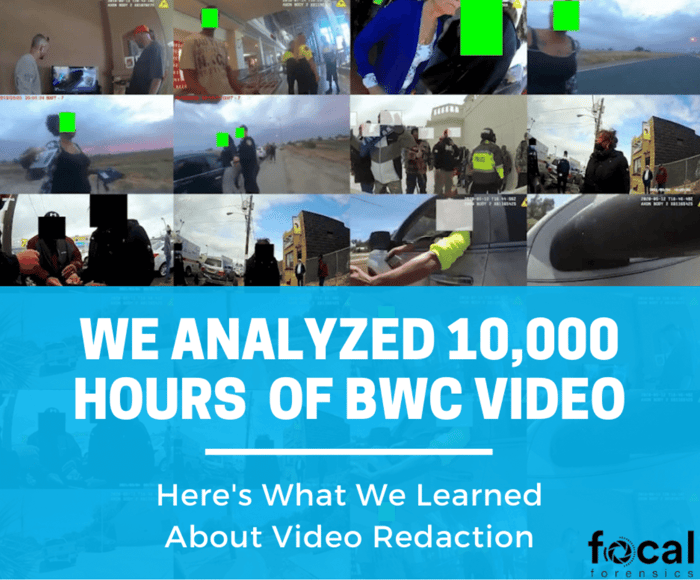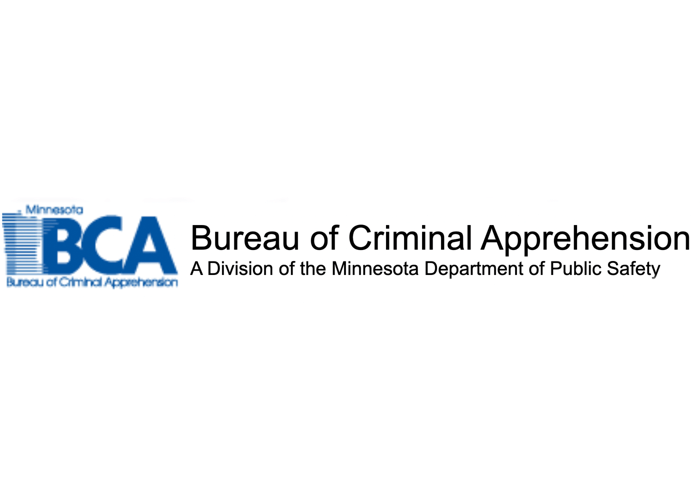Table of Contents
Introduction
In this article, we present data and video redaction lessons that we have gathered after evaluating over 10,000 hours of body-worn camera (BWC) footage. We also discuss some best practices when it comes to audio and video redaction and dive deep into the value of procuring a video redaction service provider to help with releasing BWC footage. We then break down the capabilities, staffing, and skills required to release critical incident footage within a 10-day period by using a real case scenario. Lastly, we discuss what can be done to meet narrow deadlines as the volume of BWC footage requests continues to grow.
When it comes to releasing BWC videos, the topic of privacy has been discussed by journalists and the media at great length. However, what is not well understood are the tools, skills, knowledge, and effort that go into the successful release of BWC footage.
In many states, once a video is captured and stored, it is subject to public records requests. However, before a BWC video can be released, it must be in compliance with all state statutes and court orders governing the privacy of individuals depicted in the video. This means that each video must be carefully reviewed by departmental staff and may require the use of redaction software, which can be complex and cumbersome. This redaction work adds significant costs to the overall BWC program and requires staff time to operate on a daily basis.
Although BWCs have proven to be a valuable tool when it comes to transparency, the speed of deployment in smaller agencies can be hampered by financial restrictions. Additionally, the hidden costs associated with video redaction can be overlooked, which can hinder the overall goal of transparency when BWC footage fails to get released. Some agencies, such as Bremerton Police WA, have been forced to abandon their BWC program entirely after receiving an overwhelming amount of public records requests. Fortunately, when a department finds itself drowning in such demands, other alternatives exist before having to shut down a BWC program entirely. The most beneficial and cost-effective of those alternatives is obtaining assistance from a credible and competent redaction service provider.
First, we pose the following questions: Do you really need to have the ability to release BWC video from a critical incident within just 10 days? Would such an expeditious mandate ever be considered, let alone implemented?
Recently, in Bexar County Texas, the county commissioners approved a mandatory requirement to release BWC footage for all critical incidents within just 10 days. Unfortunately, it is very unlikely that these commissioners had the opportunity to explore the nuances and work necessary to protect the privacy of individuals prior to the release of BWC video. The county commissioners are under a false assumption that current redaction software can process these critical incident requests swiftly with near-flawless automation, which is not the case. Such unrealistic expectations are initially created due to a lack of technical video experience, often made worse by software company representatives making false and misleading claims.
In this real-world scenario, a sales representative from a well-known redaction software company was directly asked by the state commissioners whether their current software could do the redactions and complete the work within a 10-day period. The representative tried to avoid the question by replying, “I will not dictate, and can not dictate, policy for an entity of municipality. What we can do is provide the software that can automate and streamline processes that you suggested.” When pressed further about adhering to the 10-day policy, the sales representative said, “The software, in essence, is replacing the human in the process, which is manual.”
These statements have led the commission further into thinking that the software can replace and eliminate any manual work, which is not the case. The sales representative also failed to provide any further details as to how many videos it could process within that period. These claims, without taking into account the volume or complexity of the footage, have put even more pressure on this county.
So why would the salesman avoid telling the commission that maybe their software isn’t always capable of this task? After digging a little further we found a simple answer. The legislative and financial oversight body for Bexar County is mandating that the payment of the entire BWC contract is contingent upon having the capability of releasing critical incident and use of force video within 10 days. A clear reward bias and a potential loss of millions of dollars unless the salesman continues pushing his agenda.
It is imperative in this situation that the Sheriff of Bexar County fully understands the capabilities of his staff and the software he is relying on to fulfill this 10-day commitment. In most critical incidents or police-involved shootings, the total amount of video can add up quickly as each officer arrives on the scene and begins recording. It is unrealistic to expect a team of two people, which has been proposed in Bexar County, to redact and release the footage within that time frame with 100% accuracy. In order to obtain such a high level of accuracy, a full quality assurance process would also need to be implemented within the same 10-day period.
We, at Focal Forensics, have been able to gather data points from processing over five years of redaction casework. The data is specific to critical incidents and gathered from departments of all sizes within the United States. This data can help provide a better understanding of how long it would take, on average, to process this work within a department.
1400 The average number of minutes that are recorded per critical incident.
12 The average number of hours it takes a newly trained person to redact 1 hour
2 The number of people assigned to process each request within Bexar County Texas.
- Total estimated turn-around time using 2 people (in-house) = 17 days* *Based on an 8 hour shift
Using the same set of data as mentioned previously in this article, we can provide a realistic measure of what it would take to release a request within just 10 days using a professional redaction service provider.
Video redaction using a 3rd party service provider
1400 The average number of minutes that are recorded per critical incident
5 The average number of hours it takes to a professional to redact 1 hour of video
6 The average number of people we assign to each case.
- Total turnaround time using a professional redaction service provider = 3 days with 100% accuracy guaranteed.
Contractor considerations
In order to meet a quick turnaround deadline while keeping your budget in mind, one should consider having the ability to scale your redaction capabilities in a very short period of time. The only way to do this successfully is to look for a secure, competent, and trustworthy third-party provider who understands handling sensitive video evidence.
A local television station or wedding video service is not qualified to handle such work. You need a redaction provider with a strong foundational knowledge of video evidence. They should follow all CJIS guidelines laid out by the DOJ and be certified in the field of video forensics by a reputable organization. When it comes to video redaction and protecting privacy, there is simply no room for error.
Secondly, such a service must have a strong and robust quality assurance process that can eliminate any initial mistakes which could expose the identity of individuals within the video. There is much at stake during this process and it is critical to make sure the work is reviewed by a trained eye.
Lastly, you will need to ensure the provider has the integrity and trust that align with the values of your department. The reputation of a department can be damaged if even one frame is overlooked and may take years to repair.
In house considerations
When considering processing video and audio redaction work in-house, there is an excellent resource recently published by the DOJ. Some of the main considerations should include the software, internal resources, and clear communication with the requesting parties. We, at Focal Forensics, would like to expand upon the types of redaction one should be aware of and how to select the best option.
Full Frame Redaction
This method is applied during circumstances when the entire video frame needs to be obscured to protect information that is either very close to the lens of the camera or large enough to fill the entire frame. Other situational circumstances can require full-frame redaction including a hospital or private residence that could expose security information and private details. When attempting to determine if full-frame redaction is the most appropriate form of redaction, one should always take into account the type of information and the amount of transparency that is required.
Selective Redaction
As the name implies, this method is applied selectively within the video when individual faces or objects are visible on the frame and background information must be retained. This type of redaction requires the forensic video examiner to track objects using an automatic or manual process. The goal during the tracking process is to create accurate data points, keyframes, or motion information to obscure moving objects throughout sequential video frames. Many factors can inhibit the success and accuracy of motion tracking including extreme motion, poor lighting, and low-resolution video.
What about Audio redaction?
Audio redaction is completed using a linear software editing program. We, at Focal Forensics, recommend removing the portion of audio entirely, creating a brief moment of silence, instead of replacing the audio signal with a beep or tone. This recommendation is based on feedback and professional advice that tones can be distracting and create further questions, by the listener, as to what was said.
Conclusion
Video and audio redaction needs to be 100% accurate every single time. The redaction process and release of BWC footage can be achieved consistently within 10 days by using a team of qualified professionals. Working on multiple redaction requests simultaneously is not something the average department can typically manage. Redaction professionals that work on FOIA requests daily should be constantly improving their techniques, testing new software, and developing new procedures to meet ever-increasing deadlines.
Focal Forensics provides the worlds leading professional video redaction services that are cost-effective and secure. Our team of media forensic professionals are experts in processing video evidence and take great pride in assisting law enforcement with their transparency goals.
FAQs
Why is redacting body-worn camera (BWC) footage so time-consuming?
BWC redaction requires frame-by-frame review to obscure sensitive visuals (like faces and addresses) and mute or remove private audio (like names or medical info). Each hour of video can take 5–12 hours to redact depending on skill level, video quality, and complexity.
Can software fully automate BWC video redaction?
No. While some tools offer automated face or object tracking, human oversight is still critical. Software alone cannot guarantee 100% accuracy, especially in complex or low-quality footage. Manual review and quality control are essential.
Is it realistic for a small agency to redact and release footage within 10 days?
Typically no, not without dedicated staff or external help. Real-world data shows that it often takes two in-house staff about 17 business days to process footage from a single critical incident. Partnering with a qualified redaction provider can reduce the turnaround to potentially 3 days while dependent on case size and complexity.
What are the risks of rushing BWC video redaction?
Mistakes like failing to redact a bystander’s face or omitting audio redactions can lead to privacy violations, legal liability, public distrust, and reputational harm. Incomplete redactions may also violate state laws and court orders.
What qualifications should a video redaction service provider have?
Providers should follow DOJ/CJIS security guidelines, be certified in forensic video analysis, and have experience handling sensitive law enforcement footage. Look for providers with strict QA processes and a reputation for accuracy and integrity.
What’s the difference between full-frame and selective redaction?
Full-frame redaction blurs or blacks out the entire screen—used when sensitive data fills the whole frame. Selective redaction targets specific elements (e.g., faces, license plates) and preserves the rest of the scene. Both require expertise to apply correctly.
How is audio redaction handled?
Audio redaction is typically done using linear editing software. Rather than inserting tones or beeps, best practice is to remove sensitive audio segments and replace them with brief silences to minimize listener confusion or distraction.
How can agencies scale redaction work quickly to meet tight deadlines?
Agencies can scale by contracting secure, competent third-party providers who can assign multiple trained professionals to a case. This flexibility allows for high-volume processing without overburdening internal staff or sacrificing quality.
What is the impact of misleading claims from software vendors?
Overpromising by vendors can lead decision-makers to believe software is a complete solution, resulting in unrealistic policies (e.g., 10-day mandates) and under-resourced implementations. Transparency about software capabilities is critical.
Why did Bexar County, Texas mandate 10-day BWC release timelines?
The policy was driven by public pressure and vendor assurances, not operational feasibility. The local sheriff’s office was left under-resourced and overburdened, highlighting the importance of involving technical experts in policy creation.




